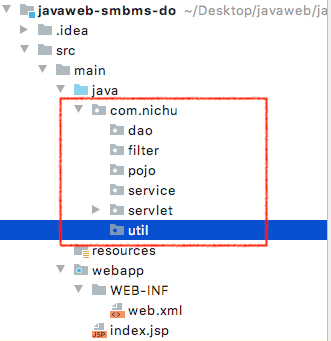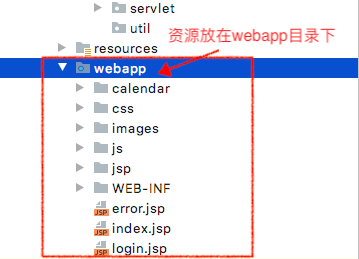SMBMS项目学习
SMBMS项目学习
基本架构

在数据库中创建对应的表
一、 搭建项目环境(准备工作)
1. 搭建一个maven web项目
2. 配置Tomcat
3. 测试项目是否能正常运行
4. 导入项目jar包
jsp,Servlet,mysql驱动,jstl,standard…
5. 创建项目包结构

6. 编写实体类pojo
7. 编写基础公共类
1. 数据库配置文件db.properties
1
2
3
4
dirver=com.mysql.jdbc.Driver
url=jdbc:mysql://localhost:3306?useUnicode=true&characterEncoding=utf-8
username=root
password=nc20011019
2. 编写数据库公共类
1 | //操作数据库的公共类 |
- 编写字符编码过滤器
1 | public class CharacterEncodingFilter implements Filter { |
8. 导入静态资源

二、登录页功能实现

1、登录功能实现
- 编写前端页面
- 设置欢迎页面
1 | <!--设置欢迎页面--> |
- 编写Dao层得到用户登录接口
1
2
3
4public interface UserDao {
//得到登录的用户
public User getLoginUser(Connection connection, String userCode) throws SQLException;
} - 编写dao接口的实现类
1
2
3
4
5
6
7
8
9
10
11
12
13
14
15
16
17
18
19
20
21
22
23
24
25
26
27
28
29
30
31
32public class UserDaoImpl implements UserDao{
public User getLoginUser(Connection connection, String userCode) throws SQLException {
ResultSet resultSet =null;
PreparedStatement preparedStatement = null;
User user = null;
if (connection!=null){
String sql="select * from smbms_user where userCode=?";
Object[] params = {userCode};
resultSet = BaseDao.execute(sql,connection,params,resultSet,preparedStatement);
if (resultSet.next()){
user = new User();
user.setId(resultSet.getInt("id"));
user.setUserCode(resultSet.getString("userCode"));
user.setUserName(resultSet.getString("userName"));
user.setUserPassword(resultSet.getString("userPassword"));
user.setGender(resultSet.getInt("gender"));
user.setBirthday(resultSet.getDate("birthday"));
user.setPhone(resultSet.getString("phone"));
user.setAddress(resultSet.getString("address"));
user.setUserRole(resultSet.getInt("userRole"));
user.setCreatedBy(resultSet.getInt("createdBy"));
user.setCreationDate(resultSet.getTimestamp("creationDate"));
user.setModifyBy(resultSet.getInt("modifyBy"));
user.setModifyDate(resultSet.getTimestamp("modifyDate"));
}
BaseDao.closeResource(null,preparedStatement,resultSet);
}
return user;
}
} - 业务层接口
在service下建立user包,建立UserService接口
1
2
3
4
5
6
7
8
9
10
11
12
13
14
15
16
17
18
19
20
21
22
23
24
25
26
27
28
29public interface UserService {
//用户登录
public User login(String userCode, String password);
}
```
6. 业务层接口实现类
``` java
public class UserServiceImpl implements UserService{
//业务层都会调用Dao层,所以要引用Dao层
private UserDao userDao;
public UserServiceImpl(){
userDao = new UserDaoImpl();
}
public User login(String userCode, String password) {
Connection connection = null;
User user = null;
try {
connection = BaseDao.getConnection();
//通过业务层调用对应的具体的数据库
user = userDao.getLoginUser(connection,userCode);
} catch (SQLException throwables) {
throwables.printStackTrace();
}finally {
BaseDao.closeResource(connection,null,null);
}
return user;
}
} - 编写Servlet类
在Servlet包中创建user包,在user包中建立LoginServlet类
1
2
3
4
5
6
7
8
9
10
11
12
13
14
15
16
17
18
19
20
21
22
23
24
25
26
27
28
29
30
31
32public class LoginServlet extends HttpServlet {
//Servlet:控制层,调用业务层代码
protected void doGet(HttpServletRequest req, HttpServletResponse resp) throws ServletException, IOException {
System.out.println("LoginServlet--start....");
//获取用户名和密码
String userCode = req.getParameter("userCode");
String userPassword = req.getParameter("userPassword");
//和数据库中的密码进行对比,调用业务层;
UserService userService = new UserServiceImpl();
User user = userService.login(userCode, userPassword); //这里已经把登录的人给查出来了
System.out.println(userCode);
System.out.println(userPassword);
if (user!=null){ //查有此人,可以登录
//将用户的信息放到Session中;
req.getSession().setAttribute(Constants.USER_SESSION,user);
//跳转到主页
resp.sendRedirect("jsp/frame.jsp");
}else {//查无此人,无法登录
//转发回登录页面,顺带提示它,用户名或者密码错误;
req.setAttribute("error","用户名或者密码不正确");
req.getRequestDispatcher("login.jsp").forward(req,resp);
}
}
protected void doPost(HttpServletRequest req, HttpServletResponse resp) throws ServletException, IOException {
doGet(req, resp);
}
} - 在web.xml中注册
1
2
3
4
5
6
7
8<servlet>
<servlet-name>LoginServlet</servlet-name>
<servlet-class>com.kuang.servlet.user.LoginServlet</servlet-class>
</servlet>
<servlet-mapping>
<servlet-name>LoginServlet</servlet-name>
<url-pattern>/login.do</url-pattern>
</servlet-mapping>
2、注销功能实现
- 在Servlet包的user包中建立LogoutServlett类
1 | public class LogoutServlet extends HttpServlet { |
- 在web.xml中注册
1 | <servlet> |
- 设置自动注销
1 | <!-- 设置30分后session自动失效 --> |
3、 登录拦截功能实现
- 在filter中建立SysFilter类
1
2
3
4
5
6
7
8
9
10
11
12
13
14
15
16
17
18
19
20
21
22public class SysFilter implements Filter {
public void init(FilterConfig filterConfig) throws ServletException {
}
public void doFilter(ServletRequest req, ServletResponse resp, FilterChain chain) throws IOException, ServletException {
HttpServletRequest request = (HttpServletRequest) req;
HttpServletResponse response = (HttpServletResponse) resp;
//过滤器,从Session中获取用户,
User user = (User) request.getSession().getAttribute(Constants.USER_SESSION);
if (user==null){ //已经被移除或者注销了,或者未登录
response.sendRedirect("/error.jsp");
}else {
chain.doFilter(req,resp);
}
}
public void destroy() {
}
} - 在web.xml中注册
1
2
3
4
5
6
7
8
9<!--用户登录过滤器-->
<filter>
<filter-name>SysFilter</filter-name>
<filter-class>com.kuang.filter.SysFilter</filter-class>
</filter>
<filter-mapping>
<filter-name>SysFilter</filter-name>
<url-pattern>/jsp/*</url-pattern>
</filter-mapping>
二、密码修改的实现
- 导入前端素材
- 编写dao层用户修改密码的接口UserDao
UserDao接口写如下代码
1
2//修改当前用户密码
public int updatePwd(Connection connection, int id, String password) throws SQLException; - 编写UserDao 接口实现类UserDaoImpl
1
2
3
4
5
6
7
8
9
10
11
12
13public int updatePwd(Connection connection, int id, String password) throws SQLException {
PreparedStatement pstm = null;
int execute = 0;
if (connection!=null){
String sql = "update smbms_user set userPassword = ? where id = ?";
Object params[] = {password,id};
execute = BaseDao.execute(connection, sql, params, pstm);
BaseDao.closeResource(null,pstm,null);
}
return execute;
} - 编写业务层接口
在service的user包中的UserService接口中添加如下代码
1
2
3//根据用户ID修改密码
public boolean updatePwd(int id, String pwd); - 编写业务层接口实现类
在service的user包中的UserServiceImpl类中添加以下代码
1
2
3
4
5
6
7
8
9
10
11
12
13
14
15
16public boolean updatePwd(int id, String pwd) {
Connection connection = null;
boolean flag = false;
//修改密码
try {
connection = BaseDao.getConnection();
if (userDao.updatePwd(connection,id,pwd)>0){
flag = true;
}
} catch (SQLException e) {
e.printStackTrace();
}finally {
BaseDao.closeResource(connection,null,null);
}
return flag;
} - 编写Servlet类
在Servlet包中的user包中建立UserServlet类
1
2
3
4
5
6
7
8
9
10
11
12
13
14
15
16
17
18
19
20
21
22
23
24
25
26
27
28
29
30
31
32
33
34
35
36
37
38
39
40
41
42
43
44
45
46
47
48
49
50
51
52
53
54
55
56
57
58
59
60
61
62
63
64
65
66
67
68
69
70
71
72
73
74
75
76
77
78
79
80
81
82
83
84
85
86
87
88
89
90
91
92
93
94
95public class UserServlet extends HttpServlet {
protected void doGet(HttpServletRequest req, HttpServletResponse resp) throws ServletException, IOException {
String method = req.getParameter("method");
if (method.equals("savepwd")&&method!=null){
this.updatePwd(req,resp);
}else if (method.equals("pwdmodify")){
this.pwdModify(req, resp);
}
}
protected void doPost(HttpServletRequest req, HttpServletResponse resp) throws ServletException, IOException {
doGet(req, resp);
}
//修改密码
public void updatePwd(HttpServletRequest req, HttpServletResponse resp){
//从Session里面拿ID;
Object o = req.getSession().getAttribute(Constants.USER_SESSION);
String newpassword = req.getParameter("newpassword");
System.out.println("UserServlet:"+newpassword);
boolean flag = false;
System.out.println(o!=null);
System.out.println(StringUtils.isNullOrEmpty(newpassword));
if (o!=null && newpassword!=null){
UserService userService = new UserServiceImpl();
flag = userService.updatePwd(((User) o).getId(), newpassword);
if (flag){
req.setAttribute("message","修改密码成功,请退出,使用新密码登录");
//密码修改成功,移除当前Session
req.getSession().removeAttribute(Constants.USER_SESSION);
}else {
req.setAttribute("message","密码修改失败");
//密码修改成功,移除当前Session
}
}else {
req.setAttribute("message","新密码有问题");
}
try {
req.getRequestDispatcher("pwdmodify.jsp").forward(req,resp);
} catch (ServletException e) {
e.printStackTrace();
} catch (IOException e) {
e.printStackTrace();
}
}
//验证旧密码,session中有用户的密码
public void pwdModify(HttpServletRequest req, HttpServletResponse resp){
//从Session里面拿ID;
Object o = req.getSession().getAttribute(Constants.USER_SESSION);
String oldpassword = req.getParameter("oldpassword");
System.out.println(oldpassword);
//万能的Map : 结果集
Map<String, String> resultMap = new HashMap<String,String>();
if (o==null){ //Session失效了,session过期了
resultMap.put("result","sessionerror");
}else if (StringUtils.isNullOrEmpty(oldpassword)){ //输入的密码为空
resultMap.put("result","error");
}else {
String userPassword = ((User) o).getUserPassword(); //Session中用户的密码
if (oldpassword.equals(userPassword)){
resultMap.put("result","true");
}else {
resultMap.put("result","false");
}
}
try {
resp.setContentType("application/json");
PrintWriter writer = resp.getWriter();
//JSONArray 阿里巴巴的JSON工具类, 转换格式
/*
resultMap = ["result","sessionerror","result","error"]
Json格式 = {key:value}
*/
writer.write(JSONArray.toJSONString(resultMap));
writer.flush();
writer.close();
} catch (IOException e) {
e.printStackTrace();
}
}
}
在web.xml中注册
1 | <servlet> |
三、用户管理实现
1. 导入分页的工具类
PageSupport
userlist.jsp
2. 获取用户数量
select count(1) as count from smbms_user u,smbms_role r where u.userRole=r.id; 联表查询用户数量
- UserDao
1
2//查询用户总数
public int getUserCount(Connection connection,String username ,int userRole)throws SQLException; - UserDaoImpl
1
2
3
4
5
6
7
8
9
10
11
12
13
14
15
16
17
18
19
20
21
22
23
24
25
26
27
28
29
30
31
32
33
34
35
36
37public int getUserCount(Connection connection, String username, int userRole) throws SQLException {
//根据用户名或者角色查询用户总数
PreparedStatement pstm = null;
ResultSet rs = null;
int count = 0;
if (connection!=null){
StringBuffer sql = new StringBuffer();
sql.append("select count(1) as count from smbms_user u,smbms_role r where u.userRole = r.id");
ArrayList<Object> list = new ArrayList<Object>();//存放我们的参数
if (!StringUtils.isNullOrEmpty(username)){
sql.append(" and u.userName like ?");
list.add("%"+username+"%"); //index:0
}
if (userRole>0){
sql.append(" and u.userRole = ?");
list.add(userRole); //index:1
}
//怎么把List转换为数组
Object[] params = list.toArray();
System.out.println("UserDaoImpl->getUserCount:"+sql.toString()); //输出最后完整的SQL语句
rs = BaseDao.execute(connection, pstm, rs, sql.toString(), params);
if (rs.next()){
count = rs.getInt("count"); //从结果集中获取最终的数量
}
BaseDao.closeResource(null,pstm,rs);
}
return count;
} - UserService
1
2//查询用户总数
public int getUserCount(Connection connection,String username ,int userRole)throws SQLException; - UserServiceImpl
1
2
3
4
5
6
7
8
9
10
11
12
13
14public int getUserCount(String username, int userRole) {
Connection connection = null;
int count = 0;
try {
connection = BaseDao.getConnection();
count = userDao.getUserCount(connection, username, userRole);
} catch (SQLException e) {
e.printStackTrace();
} finally {
BaseDao.closeResource(connection,null,null);
}
return count;
}
2.获取用户列表
- UserDao
1
2//通过条件查询-userList
public List<User> getUserList(Connection connection, String userName, int userRole, int currentPageNo, int pageSize)throws Exception; - UserDaoImpl
1
2
3
4
5
6
7
8
9
10
11
12
13
14
15
16
17
18
19
20
21
22
23
24
25
26
27
28
29
30
31
32
33
34
35
36
37
38
39
40
41public List<User> getUserList(Connection connection, String userName,int userRole,int currentPageNo, int pageSize)
throws Exception {
PreparedStatement pstm = null;
ResultSet rs = null;
List<User> userList = new ArrayList<User>();
if(connection != null){
StringBuffer sql = new StringBuffer();
sql.append("select u.*,r.roleName as userRoleName from smbms_user u,smbms_role r where u.userRole = r.id");
List<Object> list = new ArrayList<Object>();
if(!StringUtils.isNullOrEmpty(userName)){
sql.append(" and u.userName like ?");
list.add("%"+userName+"%");
}
if(userRole > 0){
sql.append(" and u.userRole = ?");
list.add(userRole);
}
sql.append(" order by creationDate DESC limit ?,?");
currentPageNo = (currentPageNo-1)*pageSize;
list.add(currentPageNo);
list.add(pageSize);
Object[] params = list.toArray();
System.out.println("sql ----> " + sql.toString());
rs = BaseDao.execute(connection, pstm, rs, sql.toString(), params);
while(rs.next()){
User _user = new User();
_user.setId(rs.getInt("id"));
_user.setUserCode(rs.getString("userCode"));
_user.setUserName(rs.getString("userName"));
_user.setGender(rs.getInt("gender"));
_user.setBirthday(rs.getDate("birthday"));
_user.setPhone(rs.getString("phone"));
_user.setUserRole(rs.getInt("userRole"));
_user.setUserRoleName(rs.getString("userRoleName"));
userList.add(_user);
}
BaseDao.closeResource(null, pstm, rs);
}
return userList;
} - UserService
1
2//查询记录数
public int getUserCount(String username,int userRole); - UserServiceImpl
1
2
3
4
5
6
7
8
9
10
11
12
13
14
15
16
17public List<User> getUserList(String queryUserName, int queryUserRole, int currentPageNo, int pageSize) {
Connection connection = null;
List<User> userList = null;
System.out.println("queryUserName ---- > " + queryUserName);
System.out.println("queryUserRole ---- > " + queryUserRole);
System.out.println("currentPageNo ---- > " + currentPageNo);
System.out.println("pageSize ---- > " + pageSize);
try {
connection = BaseDao.getConnection();
userList = userDao.getUserList(connection, queryUserName,queryUserRole,currentPageNo,pageSize);
} catch (Exception e) {
e.printStackTrace();
}finally{
BaseDao.closeResource(connection, null, null);
}
return userList;
}
3.获取角色操作
- UserDao
1
2//获取角色列表
public List<Role> getRoleList(Connection connection)throws SQLException; - UserDaoImpl
1
2
3
4
5
6
7
8
9
10
11
12
13
14
15
16
17
18
19
20
21
22
23
24
25public class RoleDaoImpl implements RoleDao {
//获取角色列表
public List<Role> getRoleList(Connection connection) throws SQLException {
PreparedStatement pstm = null;
ResultSet resultSet = null;
ArrayList<Role> roleList = new ArrayList<Role>();
if (connection!=null){
String sql = "select * from smbms_role";
Object[] params = {};
resultSet = BaseDao.execute(connection, pstm, resultSet, sql, params);
while (resultSet.next()){
Role _role = new Role();
_role.setId(resultSet.getInt("id"));
_role.setRoleCode(resultSet.getString("roleCode"));
_role.setRoleName(resultSet.getString("roleName"));
roleList.add(_role);
}
BaseDao.closeResource(null,pstm,resultSet);
}
return roleList;
}
} - UserService
1
2//获取角色列表
public List<Role> getRoleList(); - UserServiceImpl
1
2
3
4
5
6
7
8
9
10
11
12
13
14
15
16
17
18
19
20
21
22
23public class RoleServiceImpl implements RoleService {
//引入Dao
private RoleDao roleDao;
public RoleServiceImpl() {
roleDao = new RoleDaoImpl();
}
public List<Role> getRoleList() {
Connection connection = null;
List<Role> roleList = null;
try {
connection = BaseDao.getConnection();
roleList = roleDao.getRoleList(connection);
} catch (SQLException e) {
e.printStackTrace();
} finally {
BaseDao.closeResource(connection,null,null);
}
return roleList;
}
}
4.编写Servlet类
1 | //添加一个if判断 |
-------------本文结束感谢您的阅读-------------